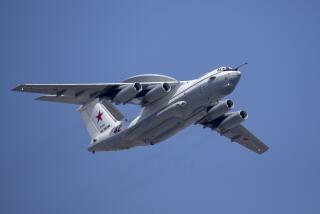MiG-21 to make a final landing
- Share via
BRUSSELS — The MiG-21 came to symbolize the military might of the Soviet Union as it squared off against the West in conflicts in Vietnam, Africa and the Middle East.
Now, exactly 50 years after it entered service, the jet fighter is approaching the twilight of its career in frontline service, but with NATO, a Cold War rival of the former Soviet Union.
The rugged and agile jet earned a reputation as a versatile and effective short-range interceptor with low operating costs and excellent performance. Like the Kalashnikov rifle -- another weapon that epitomized Soviet power -- the MiG-21 holds a unique place in military history.
“It was one of the best fighters ever, very reliable, and a real challenge to all pilots who fought against it,” said David Ivry, a former chief of the Israeli Air Force who battled MiG-21s as a squadron leader in the 1967 Arab Israeli War and as a commander in 1973 and 1982.
MiGs derived their name from the initials of their designers, Artem Mikoyan and Mikhail Gurevich. Codenamed Fishbed by the North Atlantic Treaty Organization, the MiG-21 gained fame during the Vietnam War, when it was used by the North Vietnamese to intercept American bombers.
Although heavily outnumbered, the small MiGs could evade radar and ambush formations with hit-and-run attacks in which many U.S. jets, including top-of-the line F-4 Phantoms, were downed or forced to abort their missions.
“The MiG-21 was lighter and more agile than the Phantom, which gave it a better chance to survive in a dogfight,” wrote Russian aviation historian Vladimir Babich.
The U.S. Air Force first gained vital insight on its capabilities after a defecting Iraqi pilot took one to Israel in 1966.
The plane’s performance was enhanced over the years, but designers never succeeded in overcoming the limited fuel capacity. Another weakness was thick windshield framing that reduced forward visibility, a problem during combat.
More than 10,000 MiG-21s were built, making it the most widely produced fighter ever.
The delta-winged Mach 2 interceptor -- double the speed of sound -- was widely exported and became the backbone of about 50 air forces in Europe, Africa and Asia. It was used in a dozen conflicts in the last 30 years, more than any other fighter in history.
In the 1970s, the U.S. introduced two jets that outperformed the MiG-21 -- the F-15 Eagles and F-16 Fighting Falcons. The Soviets countered with MiG-29s and Sukhoi-27s. By the 1980s, the aging MiGs were relegated to second-line duties, such as reconnaissance.
Russia has long since retired the MiG-21, but it remains operational with numerous air forces around the world.
After the collapse of the Soviet Union and the Warsaw Pact, former East European allies joined NATO, bringing more than 200 of their aging MiG-21s into the alliance.
Most have since been replaced, but the old aircraft soldiers on in NATO members Romania and Bulgaria, and in Croatia, scheduled to join the alliance next year. All three plan to retire the planes over the next three or four years.
Alen Warnes, editor of Air Forces Monthly, noted the MiG-21 is the last fighter from the 1950s to remain operational and that no other fighter has achieved such longevity.
More to Read
Sign up for Essential California
The most important California stories and recommendations in your inbox every morning.
You may occasionally receive promotional content from the Los Angeles Times.










